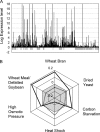Genomics of Aspergillus oryzae: learning from the history of Koji mold and exploration of its future
- PMID: 18820080
- PMCID: PMC2575883
- DOI: 10.1093/dnares/dsn020
Genomics of Aspergillus oryzae: learning from the history of Koji mold and exploration of its future
Abstract
At a time when the notion of microorganisms did not exist, our ancestors empirically established methods for the production of various fermentation foods: miso (bean curd seasoning) and shoyu (soy sauce), both of which have been widely used and are essential for Japanese cooking, and sake, a magical alcoholic drink consumed at a variety of ritual occasions, are typical examples. A filamentous fungus, Aspergillus oryzae, is the key organism in the production of all these traditional foods, and its solid-state cultivation (SSC) has been confirmed to be the secret for the high productivity of secretory hydrolases vital for the fermentation process. Indeed, our genome comparison and transcriptome analysis uncovered mechanisms for effective degradation of raw materials in SSC: the extracellular hydrolase genes that have been found only in the A. oryzae genome but not in A. fumigatus are highly induced during SSC but not in liquid cultivation. Also, the temperature reduction process empirically adopted in the traditional soy-sauce fermentation processes has been found to be important to keep strong expression of the A. oryzae-specific extracellular hydrolases. One of the prominent potentials of A. oryzae is that it has been successfully applied to effective degradation of biodegradable plastic. Both cutinase, responsible for the degradation of plastic, and hydrophobin, which recruits cutinase on the hydrophobic surface to enhance degradation, have been discovered in A. oryzae. Genomic analysis in concert with traditional knowledge and technology will continue to be powerful tools in the future exploration of A. oryzae.
Figures




Similar articles
-
Genomics of Aspergillus oryzae.Biosci Biotechnol Biochem. 2007 Mar;71(3):646-70. doi: 10.1271/bbb.60550. Epub 2007 Mar 7. Biosci Biotechnol Biochem. 2007. PMID: 17341818 Review.
-
Impact of Aspergillus oryzae genomics on industrial production of metabolites.Mycopathologia. 2006 Sep;162(3):143-53. doi: 10.1007/s11046-006-0049-2. Mycopathologia. 2006. PMID: 16944282 Review.
-
Cell biology of the Koji mold Aspergillus oryzae.Biosci Biotechnol Biochem. 2015;79(6):863-9. doi: 10.1080/09168451.2015.1023249. Epub 2015 Mar 17. Biosci Biotechnol Biochem. 2015. PMID: 25776568 Review.
-
Prediction, biochemical characterization and application of key proteolytic enzymes from aspergillus oryzae BL18 in soy sauce fermentation.Food Res Int. 2025 Jun;211:116382. doi: 10.1016/j.foodres.2025.116382. Epub 2025 Apr 16. Food Res Int. 2025. PMID: 40356105
-
Phenotypic, Genomic, and Transcriptomic Comparison of Industrial Aspergillus oryzae Used in Chinese and Japanese Soy Sauce: Analysis of Key Proteolytic Enzymes Produced by Koji Molds.Microbiol Spectr. 2023 Feb 6;11(2):e0083622. doi: 10.1128/spectrum.00836-22. Online ahead of print. Microbiol Spectr. 2023. PMID: 36744888 Free PMC article.
Cited by
-
Advances in Genetic Engineering Technology and Its Application in the Industrial Fungus Aspergillus oryzae.Front Microbiol. 2021 Feb 23;12:644404. doi: 10.3389/fmicb.2021.644404. eCollection 2021. Front Microbiol. 2021. PMID: 33708187 Free PMC article. Review.
-
Modified Cre-loxP recombination in Aspergillus oryzae by direct introduction of Cre recombinase for marker gene rescue.Appl Environ Microbiol. 2012 Jun;78(12):4126-33. doi: 10.1128/AEM.00080-12. Epub 2012 Apr 13. Appl Environ Microbiol. 2012. PMID: 22504800 Free PMC article.
-
Aspergillus oryzae-Saccharomyces cerevisiae Consortium Allows Bio-Hybrid Fuel Cell to Run on Complex Carbohydrates.Microorganisms. 2016 Feb 4;4(1):10. doi: 10.3390/microorganisms4010010. Microorganisms. 2016. PMID: 27681904 Free PMC article.
-
The evolutionary imprint of domestication on genome variation and function of the filamentous fungus Aspergillus oryzae.Curr Biol. 2012 Aug 7;22(15):1403-9. doi: 10.1016/j.cub.2012.05.033. Epub 2012 Jul 12. Curr Biol. 2012. PMID: 22795693 Free PMC article.
-
Biocontrol strain Aspergillus flavus WRRL 1519 has differences in chromosomal organization and an increased number of transposon-like elements compared to other strains.Mol Genet Genomics. 2018 Dec;293(6):1507-1522. doi: 10.1007/s00438-018-1474-x. Epub 2018 Aug 11. Mol Genet Genomics. 2018. PMID: 30099586
References
-
- Christensen T., Woeldike H., Boel E., Mortensen S. B., Hjortshoej K., Thim L., Hansen M. T. High level expression of recombinant genes in Aspergillus oryzae. Bio/Technology. 1988;6:1419–1422.
-
- Murakami H. Koji-gaku (in Japanese) Brewing Society of Japan.; 1980.
-
- Gomi K., Abe K. The Aspergilli: Genomics, Medical Applications, Biotechnology, and Research Methods (Mycology) Boca Raton, FL: CRC Press; 2007. Food products fermented by Aspergillus oryzae; pp. 427–437.
-
- Murai T. Tane-Koji Konjaku Monogatari (in Japanese) Shushi-Kenkyu. 1989;7:39–44.
-
- Hata Y., Ishida H. Glucoamylase-encoding genes of Aspergillus oryzae—Monograph (in Japanese) Seibutsu-kogaku. 2000;78:120–127.
Publication types
MeSH terms
Substances
LinkOut - more resources
Full Text Sources
Other Literature Sources

